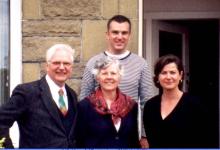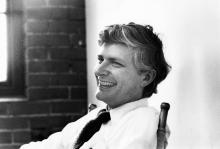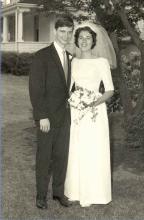Deceased July 31, 2001
View alumni profile (log in required)
In Memory
It is no surprise that Bob Harper became an architect, for in eighth grade, he and a classmate built a model of their elementary school out of shirt cardboards. But other of his early enthusiasms might have won out over architecture. His Harper grandmother taught him Scottish folk songs and introduced him to the poetry of Robert Burns, instilling in him, not only a love of Burns and the songs, but a life-long engagement with his Scottish heritage that manifested itself in many ways, though never in the lack of generosity ungenerously ascribed to the Scots.
Many of us as teenagers were obsessed with discriminating among all possible varieties of late model automobiles, but Bob had his eye on bigger game. He was lavishing similar attention on steam locomotives, cataloging them by type, manufacturer, and vintage. He and a friend would drive the roads around Rochester, tracking down and photographing these endangered species in action. Photography, a hobby natural for a son of the comptroller of Eastman-Kodak to acquire, remained one of Bob’s long-term interests, as did the trains he captured on film.
At Amherst Bob majored in Mathemetics, winning the Department’s Walker Prize.. He was a member of Psi U and served as the chapter’s treasurer. One fateful evening in his senior year, Bob met Patricia Hornberger, flutist and prospective music major, at a mixer for Smith freshmen. A relationship was born. It flourished during three years of separation while Patricia completed her Smith career and Bob earned a master’s degree from the Columbia University School of Architecture, part of which time he spent studying in France at L’École des Beaux Arts, Fontainebleau. They were married on August 29, 1964, and promptly left for Europe. This trip was funded by a fellowship that Bob had won to study mill buildings and towns of early Industrial Age in Scotland. “He was always concerned with how people lived in a designed complex,” Patricia says.
In the three years following their return to Connecticut in 1965, Patricia achieved a master’s degree from the Yale School of Music while Bob worked in the small firm of Paul Mitarachi (Amherst ’43). As Mitarachi’s only employee for most of that time, Bob had exposure to many aspects and tasks of an architect’s profession, a great educational opportunity it was.
In 1969 Bob began work for Charles W. Moore.  Their office moved from New Haven to Essex, Connecticut, the following year. and Bob designedand built a house there for his family, which now included two year old son, Ian. The arrival of daughter Mary Alice in 1971 completed the Harper family unit.
Their office moved from New Haven to Essex, Connecticut, the following year. and Bob designedand built a house there for his family, which now included two year old son, Ian. The arrival of daughter Mary Alice in 1971 completed the Harper family unit.
The Moore firm flourished, and in 1975 was renamed Moore Grover Harper to include its two new principals, Bob and William Grover. Further evolution required another name. The firm became Centerbrook Architects in 1984. Some of Bob’s most important projects were launched by Moore Grover Harper, notably the planning for expansion of art and athletic facilities at Williams College, which led to a two-stage enlargement of the Williams Art Museum. It took until the ’90s for Bob’s work to appear on the Amherst campus. First came redesign of the Keefe Science Library in Merrill. Soon after, Centerbrook designed the Life Sciences building, McGuire Hall.
Centerbook’s accomplishments were recognized by the architectural community in the form of various awards and by Bob’s election in 1985 to the College of Fellows of the American Institute of Architects. The final period of his professional career began in 1997 when he established a solo practice focusing on renovations, restorations, and private homes. He was serving as a trustee of the Connecticut Trust for Historic Preservation at the time of his sudden death at home on July 31, 2004.
Bob is warmly remembered as a teacher and mentor. At various times he served as a visiting critic at Rhode Island School of Design, Yale, and Carnegie-Mellon. But he taught in other settings, too, starting at home. Ian says, “We never had the toys the other kids had. We had unique toys our father had made for us.” He encouraged them to make their own, and taught them skills for doing so. He built his own toys, too, among them three working model train layouts that served as focal points of Christmas festivities. Many facets of Bob’s personality are succinctly captured in this remembrance by a Centerbrook protégé, Charles G. Mueller.
Robert Harper taught.
He taught all the time.
He taught nearly everyone he came in contact with, always in a kindly way that left one hungry for even more of his teaching.
He taught me how to keep the rain out.
He taught me how Glenn Gould sounded like he had six hands while playing Bach.
He taught me how to make pitched roofs collide imaginatively and elegantly.
He taught me to read Maurice Sendak to small children.
He taught me saw to re-saw wood on a bandsaw.
He taught me how to achieve asymmetrical balance in design.
He taught me how to drive a bit too fast.
He taught me how to enjoy screened porches.
He taught me about new-fangled satellite loudspeaker systems.
He taught me how to draft freehand window details over grid paper.
He taught me how to have a wee dram of single malt scotch.
He taught me how to ‘Save as’.
He taught me about model trains..
He taught me about trees and the wood we get from them.
He taught me how to have too much of his eggnog.
He taught me how to dimension drawings effectively.
He taught me how astonishingly radiant Grace Kelly was in ‘To Catch a Thief’.
He taught me how to design a fireplace that won’t smoke.
He taught me to always be charming and patient with clients.
He taught me to take delight in my graying hair.
He taught me how much I miss my own Dad.
Robert taught me just how much I can miss a Teacher, a Boss, a Friend.

